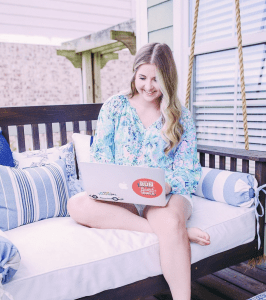Not Just a Pretty Picture: The Business of Influencing
Published on December 2, 2020, at 6:20 p.m.
by Kathleen McManus.
Influencer marketing continues to grow as a rewarding and smart way for brands to connect with consumers. According to Omnicore, 500,000 influencers are active on Instagram in 2020. In a saturated market, influencers must work smarter to compete for affiliate marketing and brand partnerships. A background in the public relations and communications industry provides influencers with the necessary skills and business acumen to set themselves apart.
While a large part of being an influencer is the front-facing content published for followers or readers, the behind-the-scenes work can benefit from a communicator’s experience. Through content creation, trend analysis, brand partnership conversations and campaign planning, the work of an influencer stretches far beyond the images and copy followers see on the screen. Much of an influencer’s day-to-day work mirrors what public relations professionals do for brands, and the skills are highly transferable.
Understanding the goal of brand partnerships
Brand partnerships are a strategy used by many organizations for years. Whether it is Draper James partnering with Crate & Barrel or Taco Bell collaborating with Doritos, major brands use this strategy to grow awareness and widen their consumer reach. Influencer partnerships are a similar strategy. The influencer is a brand, and collaborating in a partnership helps a brand expand its reach to consumers and to grow awareness.

Amy Littleson is a full-time blogger and influencer of Amy Believes in Pink. After working as a public relations and influencer marketing senior associate at Lilly Pulitzer for almost three years, Littleson took her blogging career full time earlier this year. She commented that her experience working on the brand side of influencer relations helped immensely when understanding what brands were looking for when they reached out to her for partnerships.
“Working on the brand side, I had a very clear vision of the brand’s priorities and that had a lot to do with brand positioning. Brands have a specific view of themselves and aim to be conveyed by current and potential consumers in that way,” said Littleson. She went on to add that it is the responsibility of the brand’s marketer to communicate that vision, and the responsibility of the influencer to portray the brand personality with their own unique voice.
When working as an influencer, Littleson explained, “I try to be really cognizant of a brand’s messaging and what makes up that brand. I try to keep that top of mind when I create content for them, which includes being wary of competitors, making sure their logo is shown and using brand colors and language in any copy.”
Similarly, Angela Darnell uses her background in public relations in her work as a part-time influencer and blogger of The Thrifty Pineapple. “When I work with brands as an influencer, I like to think of it as a client relationship. I am working for them, rather than asking the question of what the brand can do for me. I want to make sure that the client is happy,” said Darnell. She worked in influencer relations in a previous role at Lauren James and is currently a senior account executive at The Integer Group.
On the brand side, Darnell said that her blogging background helped her be mindful of the requests of an influencer when she reached out on behalf of the company. Having an understanding of both sides of the relationship was important when giving the proper amount of time for content creation, project details and compensation.
Utilizing transferable skills
Influencers are brand managers, and similar to the role of public relations for any organization, they must carefully manage their brand stories in the content they produce. Influencers analyze what content is resonating with followers to develop strategies for future content. This data also helps influencers when negotiating brand partnerships and pitching business.
One of the many lessons Littleson learned during her time in corporate was monitoring analytics and conducting reports, which she now does for her blog on a weekly and monthly basis. “At Lilly Pulitzer, I learned how to develop a strategy, put together a campaign deck and pitch it. I now do the same thing for myself,” said Littleson. Earlier this month, Littleson revealed her New York City apartment that included multiple brand partnerships — many of which she mentioned she pitched. Brands like Coley Home, Serena & Lily and Rifle Paper Co. worked with Littleson in designing her new space that she debuted on her blog and Instagram over the course of a week.
In addition to brand partnerships, engagement is a key advantage of influencer marketing. Influencers are a valuable resource for brands because the influencer often engages directly with potential consumers. Engagement is a key metric for influencers. These two-way conversations help retain and grow influencers’ audiences. As of 2020, 86% of women use social media for purchasing advice. Creating a well-trusted brand is key for influencers in that growth.

“As a brand, you want to make sure that you are serving your customers when you’re managing an Instagram. That means you’re replying to their direct messages, so that’s something I take a lot of pride in,” said Darnell. She added that she replies to every DM she receives and that it’s important to remember you are there to serve your audience by providing content. “If someone reached out to a company asking for details on sizing, the company would respond. I try to keep the same mindset for The Thrifty Pineapple,” she added.
Evolving into a business
Between brand partnerships and affiliate marketing, more influencers are able to turn their hobbies into side hustles or full-time careers. Affiliate marketing allows influencers to earn commission on items they link on their blogs or social media that convert to sales. Influencers are often paid by brands when partnering, which can be broken down by the number of posts, where content is posted (e.g., Instagram stories versus Instagram feed) and commission from a promo code. Having a background in business and PR management can give influencers a launchpad for strategically growing their own brands as businesses.
“I don’t think I would’ve learned how to take my hobby to a full-time business had I not had my full-time job,” said Littleson. “It helped me to run my blog like a business. As I think about potentially hiring employees one day, I think I will reflect on my time at Lilly.” Littleson commented she learned how she interacted with her bosses and learned what kind of boss she would like to be when she decides to take on employees one day.
Like many public relations positions, influencers often work well beyond the traditional workday. Many bloggers and influencers work on their side hustle part time, which means that this work does not fall into normal working hours. Influencers also follow metrics to post content during peak engagement periods, which is often early morning or during evening hours when their followers are most likely to be on social media.
“I like to say I work 9 to 5 and blog 5 to 9,” said Darnell who blogs in addition to her full-time position. She added that she carves out time on Sundays to work on creating content and has more flexibility to squeeze in blog work during this current work-from-home environment.
As brands continue to hire influencers as a key strategy in brand campaigns, the pool of influencers is likely to continue to widen. Successful influencers will stand out not just on enticing content, but on their ability to work well with brands. A background and understanding of the brand side of public relations will serve as a valuable asset to influencers and can effectively set them apart in this competitive industry as they turn their brands into businesses.




